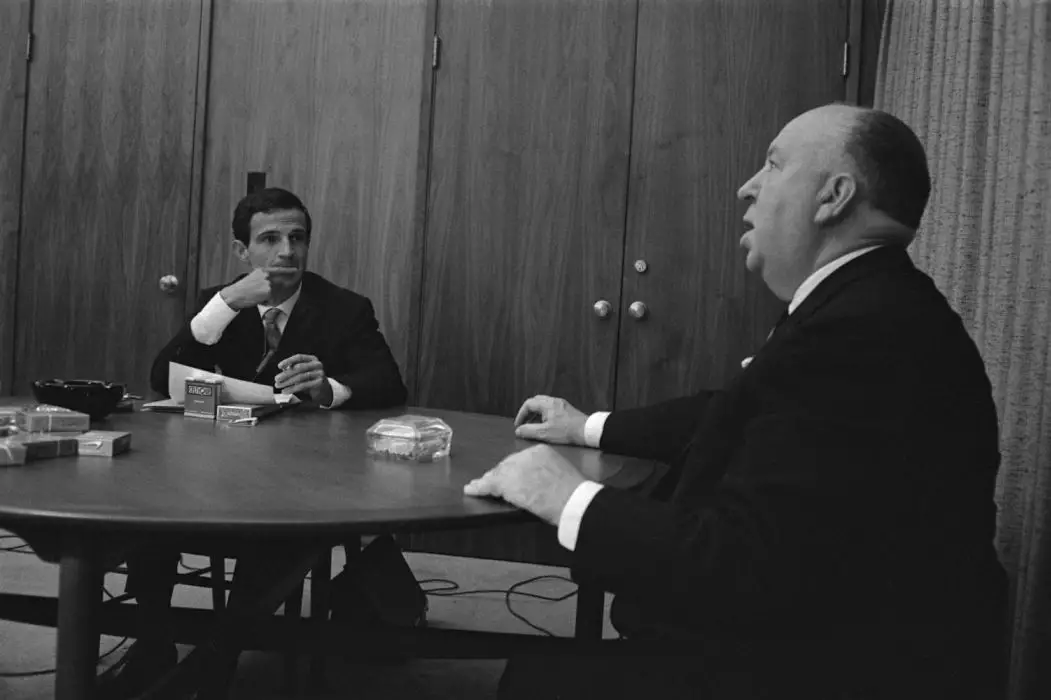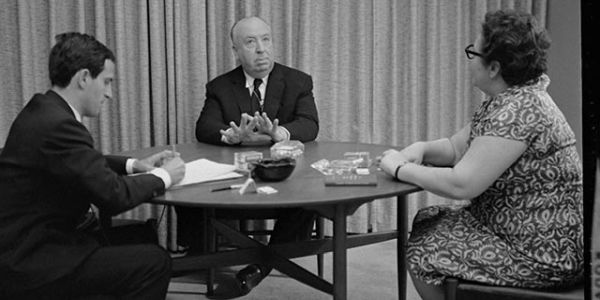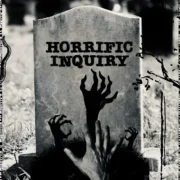HITCHCOCK/TRUFFAUT: A Deftly Crafted Gift To Cineastes

Daniel is a writer based in Sheffield, UK. He has…
For the Cahiers du Cinéma contingent, Alfred Hitchc*ck was the ultimate embodiment of the auteur theory they sought to promulgate – someone who sat comfortably within the system, making outwardly populist fare within which he was able to pursue his own thematic preoccupations. While Samuel Fuller and Nicholas Ray were always an acquired taste, there could be no disputing Hitchc*ck‘s cultural primacy, fashioning landscapes of glamour and adventure into which he injected his Freudian foreboding.
This relationship was solidified in 1962, when François Truffaut conducted a week-long series of interviews with Hitchc*ck in his office at Universal Studios during post-production on The Birds. With the help of translator Helen Scott, Truffaut sought to pierce the shell of the legendary Hitchc*ck persona and unpack the intricacies of the director’s canon. These interviews were compiled in the 1966 book “Hitchc*ck/Truffaut”, a seminal text which created concentric waves of influence: from the various European ‘New Wave’ movements to New Hollywood to the Sundance/Miramax paradigm and beyond.

Both men came into the interviews with their own goals. For Truffaut, it was an attempt to reframe Hitchc*ck in the eyes of a critical consensus which had dismissed him as nothing more than ‘the Master of Suspense’. For Hitchc*ck, it was the opportunity to guide the young director – who by this point had already made three epochal features as part of the vanguard of the Nouvelle Vague – acting as the latest in a string of father figures for Truffaut that included André Bazin, Jean Renoir and Roberto Rossellini.
A Bedrock For All Other Filmmakers
The book’s enduring appeal is apparent in the diversity of names co-writer/director Kent Jones has assembled – Martin Scorsese, Peter Bogdanovich, David Fincher, Wes Anderson, Paul Schrader, Richard Linklater, Arnaud Desplechin, James Gray, Kiyoshi Kurosawa and Oliver Assayas. One notable absence from Hitchc*ck/Truffaut is Brian De Palma, whose relationship to Hitchc*ck‘s universe is explored in Noah Baumbach and Jake Paltrow‘s fabulous career overview De Palma, which functions as a sort of companion piece.
What is immediately striking is that Jones has eschewed the usual route of using critics, historians and contemporaries to contextualize the story. Much like Hitchc*ck‘s assertion that ‘logic is dull’, Jones is not interested in biographical niceties, assuming a base level of knowledge which frees him up to delve into his contributors’ insights.
A welcome feature of Hitchc*ck/Truffaut is the degree to which the book itself is utilized; in particular the stills which break down the composition of famous scenes from the Hitchc*ck canon, and sections of text which dissolve into an illustrative visual. Rather than opt for sophisticated graphics and/or animation – which was an idea when Gail Levin was attached to direct the project – Jones simply pans over pages, reviving some of the excitement first felt by those who imbibed and were intoxicated by these words and images.

Jones – a renowned critic and essayist whose previous documentaries have dealt with Elia Kazan and Val Lewton – finds in the 27 hours of recordings much of what was lost in the book’s translation and re-translation, making ample use of Philippe Halsman‘s iconic photographs of the interviews. There is a wealth of production sketches, storyboards, publicity stills and clips which serve to underline Hitchc*ck‘s ‘mathematical sense of construction’, as Assayas describes it. Jones was keen to resists the temptation of slathering Hitchc*ck/Truffaut with Bernard Herrmann‘s music; he used Jonny Greenwood‘s scores as a temp track, and Jeremiah Bornfield‘s original score certainly carries the ragged grandeur of Greenwood‘s collaborations with Paul Thomas Anderson.
Though it offers a broad sweep of Hitchc*ck‘s oeuvre, Hitchc*ck/Truffaut dwells on the major works, with extensive analysis of Vertigo and Psycho. These sections go somewhat off-book and veer into social history and semiotics. The ‘delicate and dark obsessions’ of Vertigo are pored over, offering various readings of what had by the ’70s become to Schrader‘s generation a ‘sacred, forbidden document’; in which plot is secondary to texture and ‘subtext becomes text’.
Scorsese puts forth the proposition that Psycho presaged the ’60s in its insertion of uncertainty and peril into the standard narrative model. The ‘restraint of the frame’ in the film’s over-lit, televisual opening portion primes the audience for ‘one of the great misdirections’, plunging them into a troubling new geography.
A Work Of Fine Art And A Mirror
What emerges from the talking heads is how complex and variegated the responses are to Hitchc*ck’s canon; functioning as both a work of fine art and a mirror. Wes Anderson extols the ‘precision’ and ‘control’ of Hitchc*ck‘s visual design; Scorsese sees ‘a religious element’ in Hitchc*ck‘s use of high angles; and Schrader notices a preponderance of ‘fetish objects’ like keys, handcuffs and ropes which carry a ‘Freudian weight’. These observations tap into a quality which resides just below the surface of Hitchc*ck’s work, something that nags at the subconscious and manifests itself in wildly divergent modes of expression.

Fincher is at his loquacious best, offering a mini-master class abounding with blunt epigrams on the practicalities of ‘dealing with space’ and ‘the expansion of time’. Assayas is a fount of theoretical flourishes, describing the Nouvelle Vague as ‘the moment at which cinema becomes aware of itself’ and lauding Hitchc*ck as a ‘theoretician of space’. Bogdanovich seems chary of delving into some of the deeper resonances, and chooses to trot out anecdotes that will be very familiar to anyone who has heard him speak on the subject.
The Verdict
One of the film’s most poignant moments comes when Hitchc*ck shares his doubt over whether he should have been more experimental in his approach to character, and the feeling he had become ‘a prisoner of my own form’, laying bare the doubt which stalks even the best of their craft. What shines through in Hitchc*ck/Truffaut is the degree to which each artist changed the trajectory of the other, each seeing in the other the possibility of a realignment.
In clips like the wondrous dissolve in The Wrong Man, where the faces of the innocent and guilty man merge, we see glimpses of a ‘lost secret’ informed by silent cinema; an alternative universe in which the inertia that came with the coming of sound was ameliorated by a dynamic visual literacy; a seamless and perfectly integrated medium.
Hitchc*ck found himself occupying a fractured world in which, as Kurosawa observes, ‘he portrayed himself as a mainstream figure’ even though he was ‘at the furthest edge of things’. Part of what makes Hitchc*ck a fascinating artist is his willingness to dramatise this duality. Hitchc*ck/Truffaut is a means of coming to terms with Hitchc*ck‘s sublimation into ‘the spirit of realism’. As Fincher avers, ‘you cannot hide your interests’.
Hitchc*ck/Truffaut is more than a mere adjunct to the touchstone text. Jones has created a meticulous and perceptive work in which essay, commentary and conversation overlap, charting the strange synthesis of reverie and technique which constitutes the art of filmmaking.
What are your thoughts on the observations of the directors in Hitchc*ck/Truffaut?
Hitchc*ck/Truffaut will be available on Blu-Ray and DVD on December 20, 2016.
https://vimeo.com/141314873
Does content like this matter to you?
Become a Member and support film journalism. Unlock access to all of Film Inquiry`s great articles. Join a community of like-minded readers who are passionate about cinema - get access to our private members Network, give back to independent filmmakers, and more.
Daniel is a writer based in Sheffield, UK. He has contributed to sites like HeyUGuys, The Shiznit, Sabotage Times, Roobla, Column F and The State of the Arts. He has a propensity to wax lyrical about Film Noir on the slightest provocation, which makes him a hit at parties. The detritus of his creative outpourings can be found at waxbarricades.wordpress.com.













